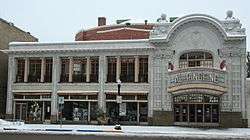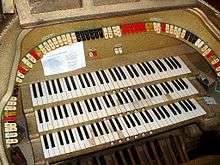Al. Ringling Theatre
The Al. Ringling Theatre in Baraboo, Wisconsin, United States, opened its doors in November 1915 and has been operating continuously ever since. Designed by the architectural firm Rapp and Rapp, it was built by Albert Ringling, one of the circus Ringling Brothers, for $100,000. Over the years, it has featured performances from vaudeville and silent movies to grand opera starring such notables as Lionel Barrymore and Mary Pickford.
Al Ringling Theatre | |
 The Al. Ringling Theatre | |
  | |
| Location | 136 4th Ave., Baraboo, Wisconsin |
|---|---|
| Coordinates | 43°28′16″N 89°44′37″W |
| Built | 1915 |
| Architect | C.W. Rapp, George L. Rapp |
| Architectural style | Beaux Arts |
| NRHP reference No. | 76000202[1] |
| Added to NRHP | May 17, 1976 |
The design of the theater is based on the Orpheum Theatre, built by Rapp and Rapp in Champaign, Illinois in 1914. The decor of the auditorium is said to have derived from Ange-Jacques Gabriel's opera house of 1763-1770 in the Palace of Versailles but some believe it to be at least equally based on Victor Louis's 1780 Grand Théâtre de Bordeaux.
Originally the theater had a Style 1 Wurlitzer[2] theater pipe organ. Later a 9 rank, 3 manual Barton with a "circus wagon" style console replaced the Wurlitzer.
The Al Ringling Theater was featured in an episode of PBS's History Detectives, where they investigated whether it was the country's first great movie palace.[3]
Notes
- "National Register Information System". National Register of Historic Places. National Park Service. March 13, 2009.
- "Profile of the Mighty Barton Organ!". Al. Ringling Theater. Archived from the original on 2009-07-26. Retrieved 23 Sep 2009.
- "Movie Palace". History Detectives. PBS. Retrieved 23 Sep 2009.
External links
- Al. Ringling Theater home page

